As any fish enthusiast will tell you, it’s important to be mindful when bringing together different types of fish. Making the wrong choices can lead to serious issues. Generally, dwarf gouramis are peaceful. However, this does not mean they can be housed with any other species. Let’s learn more about the ideal tank mates for dwarf gourami.
About Dwarf Gouramis
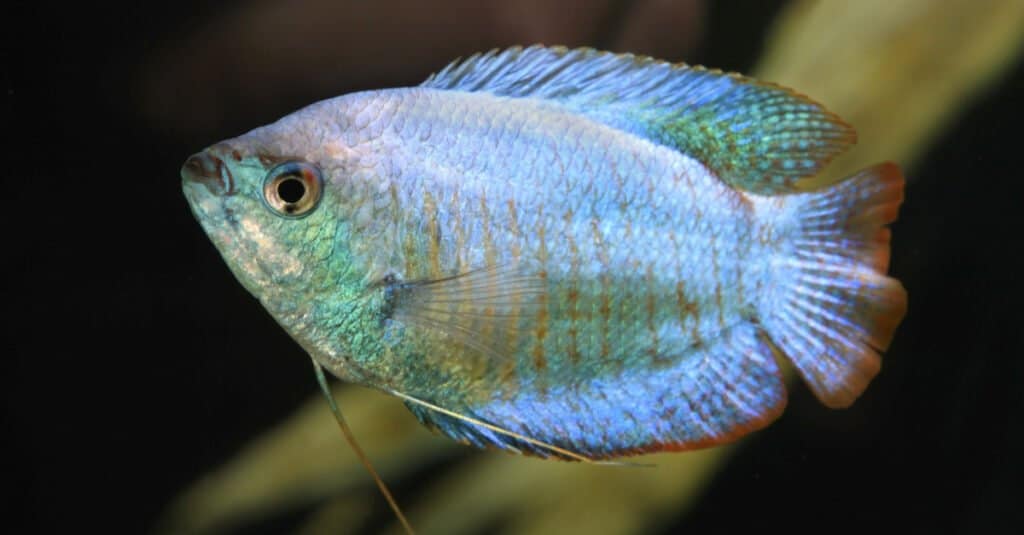
Dwarf gourami are popular aquarium fish and come in many colors.
©Steve Bower/Shutterstock.com
Due to their timid nature, dwarf gouramis are vulnerable to more aggressive or territorial fish. So it is essential to look for a fish with a calm and peaceful demeanor. Certain species should be avoided in a communal tank because they can be a big threat to dwarf gouramis. Since these fish are quite small in size, they are best paired with other fish that are of similar size. Larger species may consider them as prey which can be hazardous. It is important to make sure that the fish tank is set up in a way that gives everyone enough space to move around, feed, and feel secure. If the environment is not suitable, the fish may compete for resources and become unhealthy.
Dwarf Gourami Tank Parameters
Ensuring the well-being of your fish species, regardless of their type, heavily relies on providing them with an appropriate tank setup. When considering suitable companions for your dwarf gouramis, it is imperative to select species that not only share similar environmental requirements but also offer enough space for all inhabitants to flourish harmoniously.
The water parameters preferred by dwarf gouramis are crucial factors in maintaining their health and overall satisfaction. These vibrant creatures thrive within a specific range of conditions, including a temperature range between 77°F and 79°F. Furthermore, they prefer a pH level spanning from 6 to 8 and require water hardness ranging from 10-20 dGH.
Considering the limited capacity of a standard 10-gallon tank. It can comfortably accommodate two or three dwarf gouramis while still promoting their happiness. However, if you intend to introduce additional fish into the aquarium community alongside these delightful creatures, it becomes essential to expand the tank’s volume accordingly. As a general guideline, allocating an extra five gallons per each new addition will ensure ample space for all residents to coexist peacefully.
21 Best Tank Mates For Dwarf Gouramis
Dwarf gouramis are renowned for being placid, making them ideal for keeping in a shared aquarium. They usually mix well with other passive varieties of fish and can be kept in groups without any problems.
1. Mollies
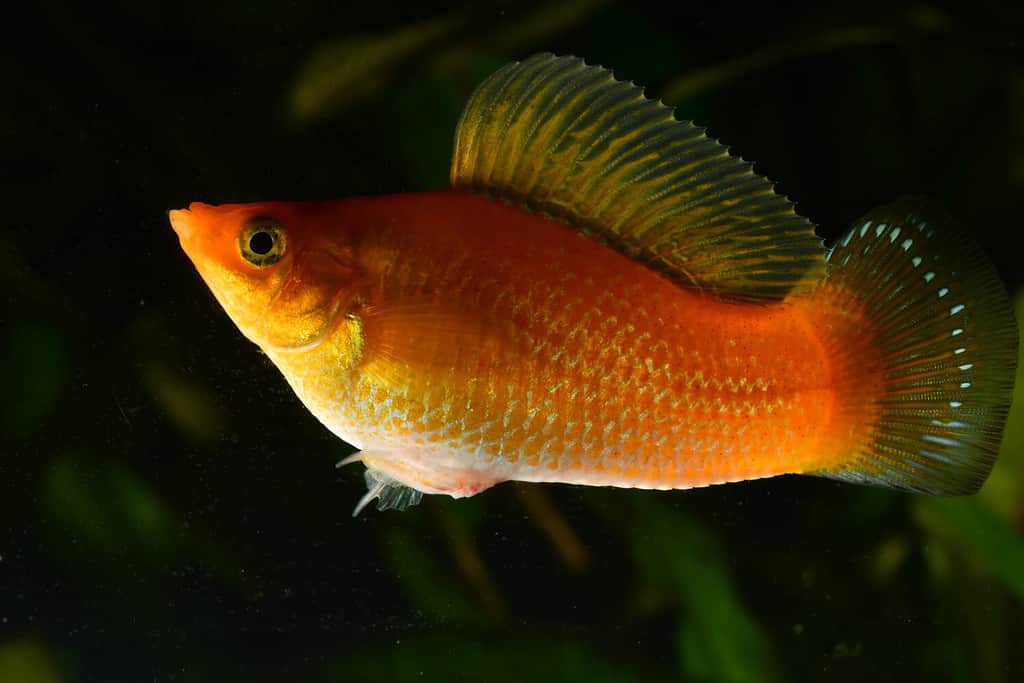
A great tank mate for dwarf gourami is a mollie fish.
©MichalNowaktv/Shutterstock.com
A mollie fish, scientifically known as Poecilia sphenops, Poecilia latipinna, or Poecilia velifera, is a popular species commonly found in freshwater aquariums. Known for their vibrant colors and lively nature, mollies are highly sought after by hobbyists worldwide.
Native to Central and South America, these tropical fishes thrive in warm water temperatures between 75°F to 82°F. Mollies exhibit various color variations. They range from black, white, and silver to gold hues with unique patterns like Dalmatian spots or marbled designs. They possess an intriguing live-bearing reproductive system where females give birth to fully formed fry instead of laying eggs. With their peaceful temperament and compatibility with other community fish species, such as guppies and tetras, mollies make excellent tank mates for dwarf gouramis.
2. Guppies
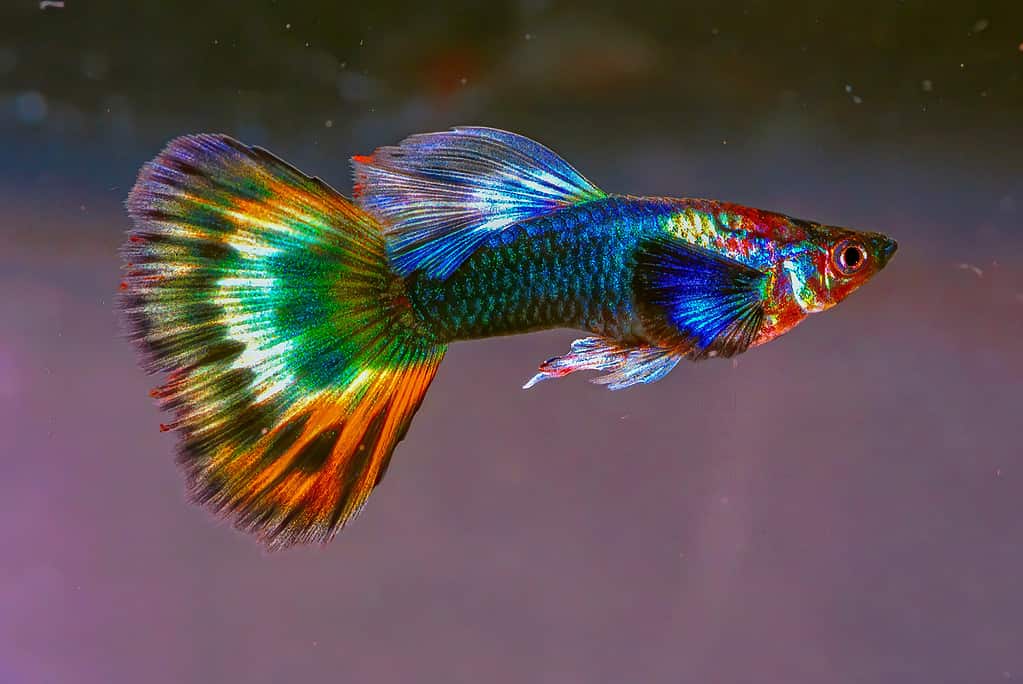
Fancy tail guppies are one of the most common guppies in the world. They are also known as fan-tailed guppies or fantail guppies.
©Karel Zahradka/Shutterstock.com
A guppie fish (Poecilia reticulata) is a small, vibrant freshwater species that hails from South America. Known for their stunning colors and lively personalities, guppies have become popular among aquarists worldwide. These charming fish possess an elongated body with a slightly upturned mouth and prominent dorsal fin. Male guppies often flaunt an array of striking hues, including vibrant reds, blues, oranges, and yellows, along their streamlined bodies. In contrast, females tend to exhibit more subdued coloration but boast elegant patterns and intricate designs.
Guppies are highly adaptable and can thrive in various water conditions. This makes them suitable for beginners as well as experienced aquarium enthusiasts. They prefer temperatures between 72-82°F with a pH range of 6.8-7.8. Guppies are also prolific breeders known for their live-bearing nature. Female guppies give birth to fully-formed fry rather than laying eggs.
Due to their peaceful temperament, guppies make excellent tank mates for many other species in community aquariums. However, it’s crucial to ensure compatible companionship based on similar water requirements. You also want to opt for non-aggressive behavior when selecting appropriate tank mates for these delightful fish.
3. Southern Playfish
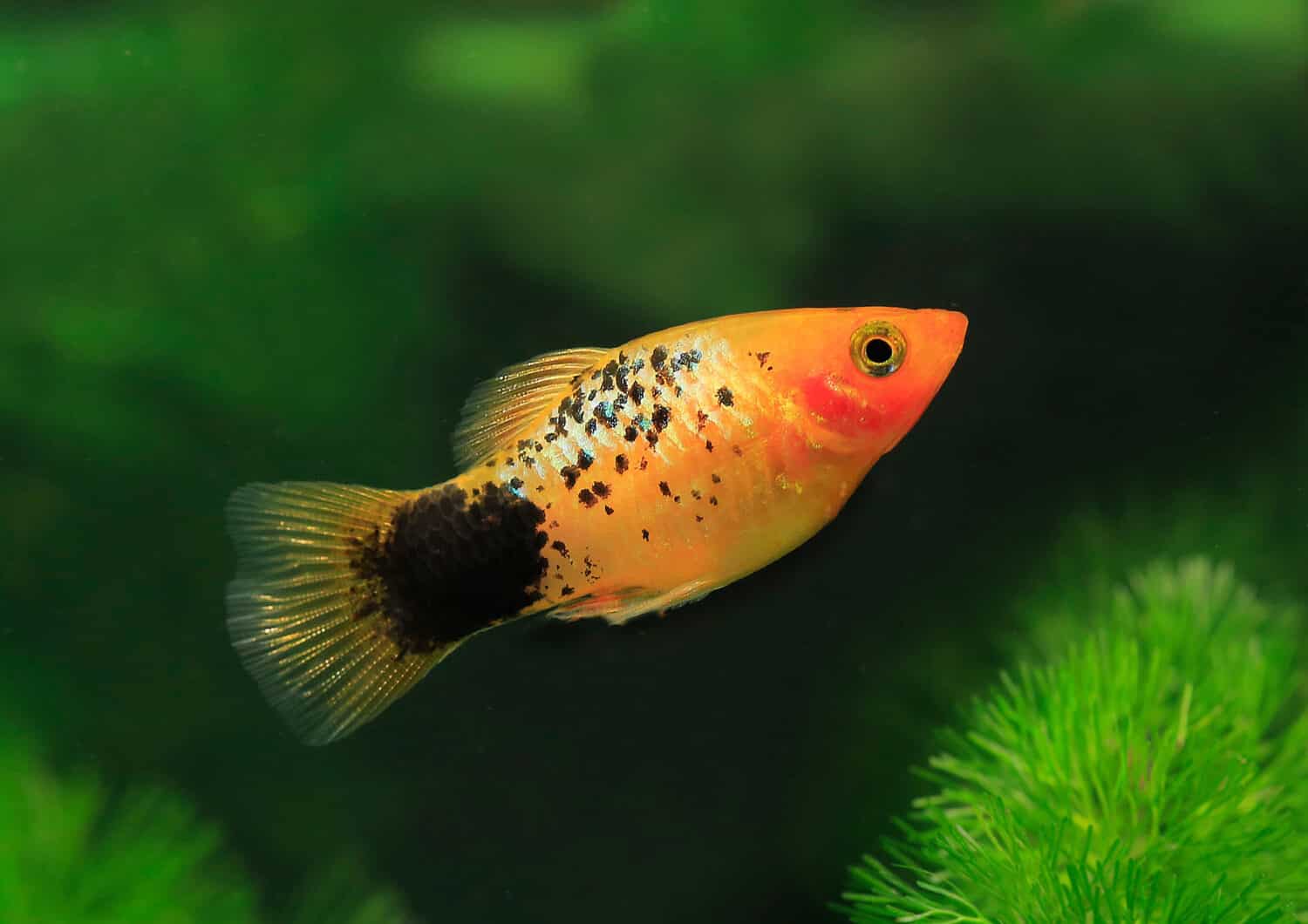
The beautiful platyfish makes a great companion for dwarf gourami.
©R. Maximiliane/Shutterstock.com
The platyfish, scientifically known as Xiphophorus maculatus, is a popular freshwater species that belongs to the family Poeciliidae. They are native to Central America and mainly found in Mexico and Guatemala. These vibrant and hardy fishes have become beloved additions to many home aquariums worldwide.
Platies are characterized by their small size, typically reaching around 2-3 inches in length. They showcase an array of captivating colors and patterns. There are variations of orange, red, yellow, blue, black, and even metallic hues. This diverse color palette makes them visually striking when kept alongside other tank mates.
Known for their peaceful nature and amiable temperament towards other community fish species, platies make great tank mates for dwarf gourami. Their calm demeanor promotes a harmonious environment within the aquarium setting. Additionally, platies are prolific breeders but pose no threat to the delicate equilibrium required by dwarf gouramis.
Take proper care and maintenance of water conditions suitable to both species’ needs. The temperature range is around 72-77°F, and pH levels are between 7.0-8.2). Pairing dwarf gouramis with lively platies can create a vibrant aquatic display while fostering mutual well-being among these beautiful creatures.
4. Swordtails
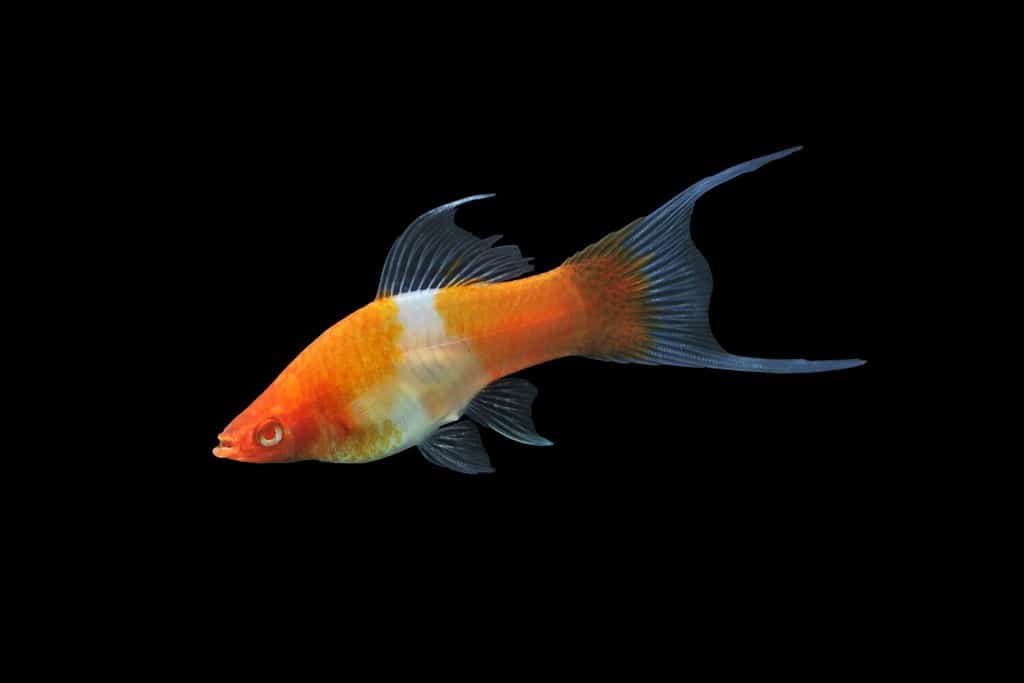
Xiphophorous helleri, or swordtail fish, are excellent tank mates for dwarf gourami.
©Arunee Rodloy/Shutterstock.com
A swordtail (Xiphophorous helleri) is a vibrant freshwater fish native to Central America, particularly Mexico and Guatemala. Renowned for its stunning appearance and active nature, the swordtail has become a popular choice among aquarium enthusiasts worldwide. This species showcases an elongated body with a distinctive “sword-like” extension in males. This sets them apart from their female counterparts.
These peaceful creatures can grow up to three inches long and boast various color variations. They range from fiery reds, oranges, and yellows to velvety blacks. Swordtails are known for their adaptability and hardiness, making them suitable for both beginner and experienced aquarists alike. With proper care and maintenance of water parameters such as temperature stability and good filtration systems, these energetic swimmers thrive well within community tanks alongside compatible species like tetras or mollies.
5. Neon Tetras
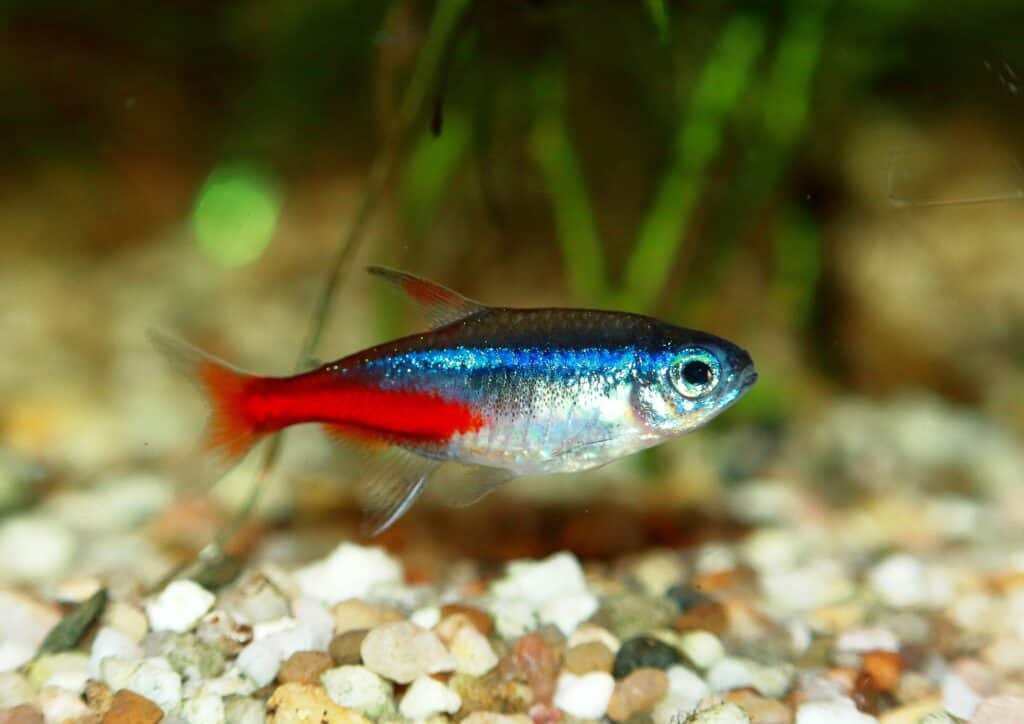
The neon tetra has a light-blue back over a silver-white abdomen and an iridescent red stripe.
©Kristiana Berzina/Shutterstock.com
A neon tetra (Paracheirodon innesi) is a captivating freshwater fish that hails from the Amazon Basin in South America. Renowned for its mesmerizing beauty, this small-sized species belongs to the family Characidae. It is highly sought after by aquarium enthusiasts worldwide. Neon Tetras have a stunning iridescent silver body adorned with vibrant horizontal stripes of neon along its sides. The neon tetra stands out as an exquisite addition to any community tank.
Growing up to 1.5 inches long, these peaceful shoaling fish thrive best in groups of six or more. This creates a visually appealing display when their colors mingle harmoniously. Neon tetras prefer well-maintained aquariums with dense vegetation mimicking their natural habitat while providing sufficient swimming space. Known for their playful nature and active behavior, they add vitality and liveliness to aquatic landscapes.
In terms of care requirements, neon tetras are generally hardy but sensitive to water conditions. Therefore, maintaining pristine water quality is crucial for their well-being. Water temperatures of 70° to 85°F are acceptable. A water pH of 6.0 is ideal. Their omnivorous diet consists of high-quality flakes or pellets. You can supplement with occasional live or frozen foods like brine shrimp or daphnia.
Overall, they have a striking appearance and are compatible with various tank mates. Neon tetras continue to captivate aquarists’ hearts as one of the top choices for community tanks featuring dwarf gouramis.
6. Chili Rasboras

Chili rasboras is a brightly colored, tiny fish that only grow to measure around half an inch in length!
©boban_nz/Shutterstock.com
Scientifically known as Boraras brigittae, chili rasboras is commonly referred to as mosquito rasboras. They are vibrant and captivating little fish that make excellent tank mates for dwarf gouramis. Originating from the peat swamp forests of Southeast Asia, particularly in Borneo and Sumatra, these diminutive creatures boast a stunning appearance. They feature fiery red bodies adorned with metallic green hues on their back and fins. Chili rasboras add a burst of color to any aquarium.
Measuring only about 0.8 inches in length, they are certainly not large fish. They exhibit a peaceful nature which makes them ideal companions for other small community fish species like dwarf gouramis. Their small size allows them to navigate easily through densely planted tanks or nano aquarium setups with limited space.
Known for their schooling behavior, chili rasboras feel most comfortable when kept in groups of at least six individuals or more. By maintaining such numbers, aquarists can witness the mesmerizing sight of these tiny gems gracefully swimming together.
In terms of care requirements, chili rasboras thrive best in well-maintained aquatic environments. Offer them soft acidic water conditions reminiscent of their native habitats. Providing ample hiding places among vegetation is recommended since it mimics their natural habitat and helps alleviate potential stress.
Overall, adding chili rasboras to an aquarium creates an eye-catching display. They are great tank mates for dwarf gourami due to their peaceful disposition and striking aesthetics.
7. Zebrafish
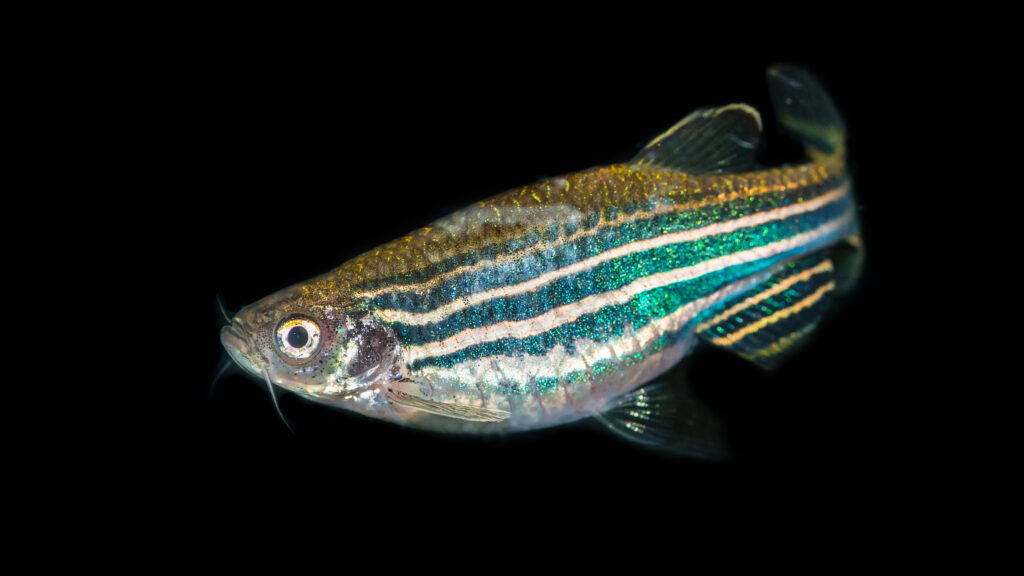
If you want a nice peaceful mate for your dwarf gourami, try out zebrafish.
©Ian Grainger/Shutterstock.com
A zebrafish is scientifically known as Danio rerio and commonly referred to as a zebra danios. It is a small freshwater fish species native to the streams and rice paddies of South Asia. People love them for their distinctive black stripes that resemble those of a zebra. These vibrant creatures have become popular among aquarium enthusiasts. Zebrafish are highly adaptable and resilient, making them suitable for both beginner and experienced fish keepers. With an average length of around 2 inches, they possess an elongated body shape with streamlined fins. This allows them to swiftly navigate through water.
In addition to their captivating appearance, zebrafish exhibit fascinating behaviors. They are social animals that thrive in groups or schools consisting of five or more individuals. This makes them great tank mates for dwarf gourami. Their playful nature and active swimming habits add liveliness to any tank environment. These peaceful community fish can coexist harmoniously with other non-aggressive freshwater species. They get along well with tetras, guppies, rasboras, and similar-sized peaceful cichlids.
Zebrafish also display unique reproductive characteristics. This makes them subjects in scientific research fields like genetics and developmental biology. Due to their transparent embryos’ external development stages being easily observable under a microscope, researchers frequently utilize them for studying various biological processes.
8. Cory Catfish

Coming in a wide range of colors, the cory
catfish
is a great fish for community tanks.
©iStock.com/Angelo D’Amico
A cory catfish, scientifically known as Corydoras, is a popular and fascinating freshwater fish species that thrive in aquariums. Belonging to the Callichthyidae family, they are native to South America. You will find them in various habitats, such as rivers, streams, and flooded areas. With their unique appearance and behavior, cory catfish have become sought-after additions to community tanks.
These small-sized catfish typically reach around 2-3 inches in length. They exhibit a flattened body shape with armored plating covering their sides. Their distinguishing feature is their barbels or whiskers located near the mouth. These help them navigate for food on the substrate. Cory catfish sport vibrant colors like bronze or pale yellowish hues with intricate patterns along their bodies. These captivating fish add visual interest to any aquarium setup.
Cory catfish are peaceful by nature and make excellent tank mates for dwarf gouramis due to their calm temperament. They prefer living in groups of five or more individuals as it provides them security and enhances their natural behaviors. These bottom-dwelling scavengers efficiently clean up leftover food particles while also sifting through sand or gravel beds during feeding time.
9. Angelfish

8 to 12 years is the average lifespan of an angelfish.
©Saad315/Shutterstock.com
An angelfish (Pterophyllum) is a beautiful and popular freshwater fish known for its graceful appearance and unique shape. Belonging to the cichlid family, angelfish are native to South America, particularly the Amazon River basin. These elegant creatures showcase triangular bodies with elongated dorsal and anal fins that resemble angel wings, hence their name.
Angelfish come in various color variations, including silver, black, marble, gold, and even albino forms. Their striking colors and patterns make them highly sought after by aquarium enthusiasts worldwide. With an average size of about four inches in captivity, they require spacious tanks with plenty of vertical swimming space due to their tall finnage.
They are known for their peaceful temperament when kept with suitable tank mates, like dwarf gourami. Angelfish can coexist well with other community fish like tetras or guppies. However, it’s important to note that aggressive or fin-nipping species should be avoided. This could cause stress or damage to the delicate long fins of these magnificent fish.
10. Bristlenose Plecos
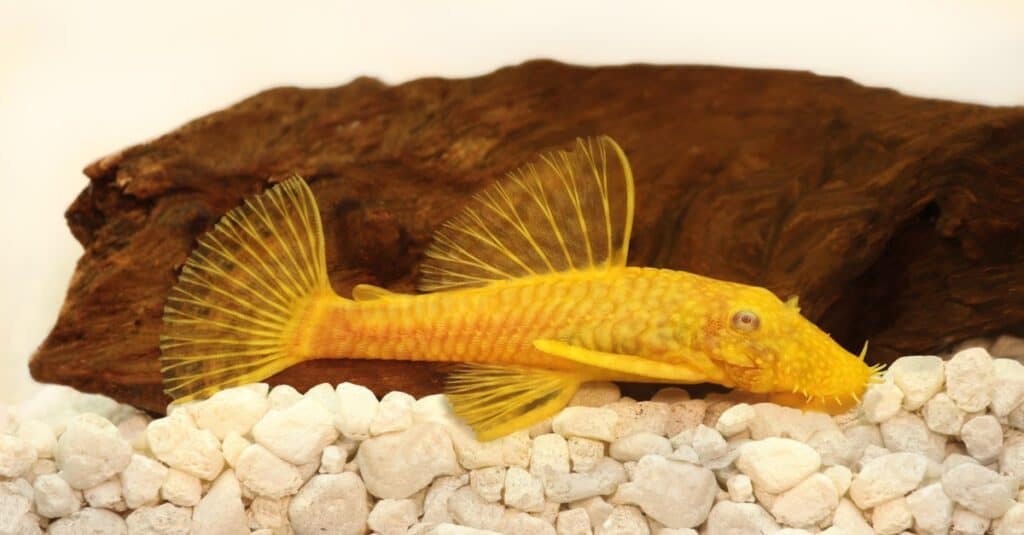
The smallest pleco fish is the bristlenose, or bushynose, catfish.
©iStock.com/Mirko_Rosenau
A bristlenose pleco, scientifically known as Ancistrus cirrhosis, is a fascinating freshwater fish species commonly referred to as bristlenose catfish or bushynose catfish. This small-sized and peaceful creature originates from South America, primarily inhabiting the Amazon River basin. Renowned for its unique appearance, the bristlenose pleco features a distinctive body covered in armor-like plates and short tentacle-like appendages called “bristles” on its head. This fish plays well with others and makes a good tank mate for dwarf gourami.
Measuring around 3 to 5 inches in length when fully grown, this catfish species showcases sexual dimorphism, with males possessing more prominent facial bristles than females. Apart from their aesthetic appeal, these whisker-like structures also serve important sensory functions for navigation and communication within their environment.
Bristlenose plecos are great algae eaters! They make excellent tank mates for various aquarium setups. With their voracious appetite for algae growth – including nuisance types like green spot algae – they play an essential role in maintaining water quality by preventing excessive build-up of unwanted plant matter. Their docile nature makes them compatible companions for other peaceful community fish species such as tetras, guppies, and rasboras.
11. Siamese Algae Eaters
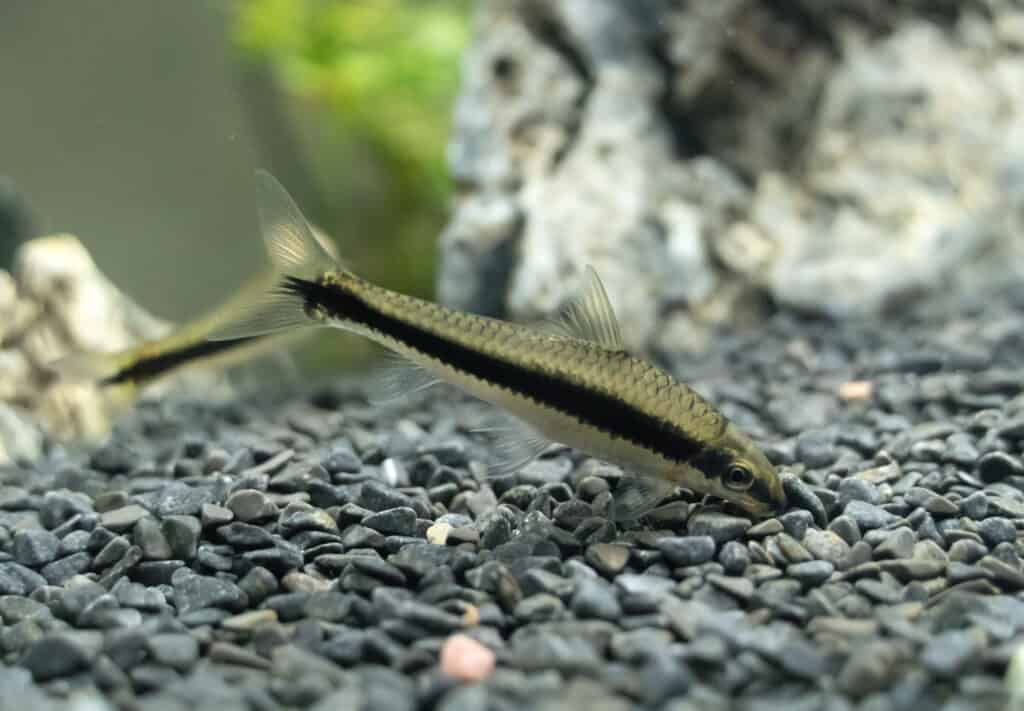
Siamese algae eaters need room to spread out and require 20 gallons of water per fish.
©M-Production/Shutterstock.com
The Siamese algae eater (Crossocheilus oblongus) is a popular freshwater fish with efficient algae-eating abilities. Native to Southeast Asia, particularly Thailand and Cambodia, this species belongs to the Cyprinidae family. With an elongated body shape and vibrant coloration, aquarium enthusiasts love Siamese Algae Eaters.
Measuring around 6 inches in length when fully grown, these peaceful and sociable creatures thrive in well-maintained tanks with plenty of swimming space. They require 20 gallons of water per fish. Their unique physiology includes a sucker-like mouth that allows them to attach themselves to various surfaces while feeding on algae growth. This remarkable adaptation makes them valuable additions to aquariums plagued by excess algae.
Siamese algae eaters prefer a diet consisting mainly of filamentous or green spot algae but also consume other types of detritus and plant matter. To ensure their optimum health, it is important to provide them with a varied diet supplemented with high-quality flake or pellet food.
Although generally compatible with most community fish species, it’s crucial to avoid keeping multiple Siamese algae eaters together as they can exhibit territorial behavior towards their own kind. Furthermore, maintaining suitable water parameters within the range of temperatures between 72-79°F (22-26°C) will promote their overall well-being.
12. Glass Catfish
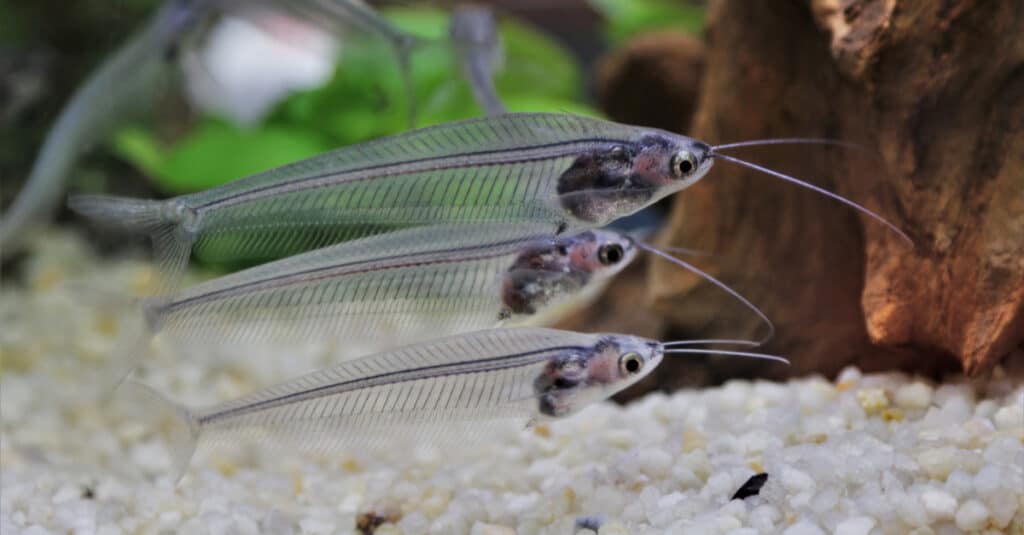
Ghost catfish, or glass catfish, is around 2.5 inches long.
©Arunee Rodloy/Shutterstock.com
A glass catfish, scientifically known as Kryptopterus vitreolus but sometimes referred to as ghost catfish, is a fascinating aquatic creature that captures the attention of fish enthusiasts. This translucent beauty hails from Southeast Asia and belongs to the family Siluridae. Renowned for its unique appearance, this species features a slender body with delicate fins and an elongated transparent structure. It derives its name from its ethereal-like transparency, allowing observers to witness its internal organs through its body.
Glass catfish are peaceful by nature and thrive in freshwater environments with ample hiding spots such as plants or driftwood. They prefer well-maintained water conditions with neutral pH levels and moderate temperatures ranging between 73-80°F. While they primarily feed on small live or frozen foods like bloodworms or brine shrimp, they also accept high-quality flake or pellet food.
These captivating creatures are often sought after by aquarists due to their mesmerizing appearance and gentle temperament. When considering compatible tank mates for dwarf gouramis, the glass catfish is a great choice.
13. German Blue Rams
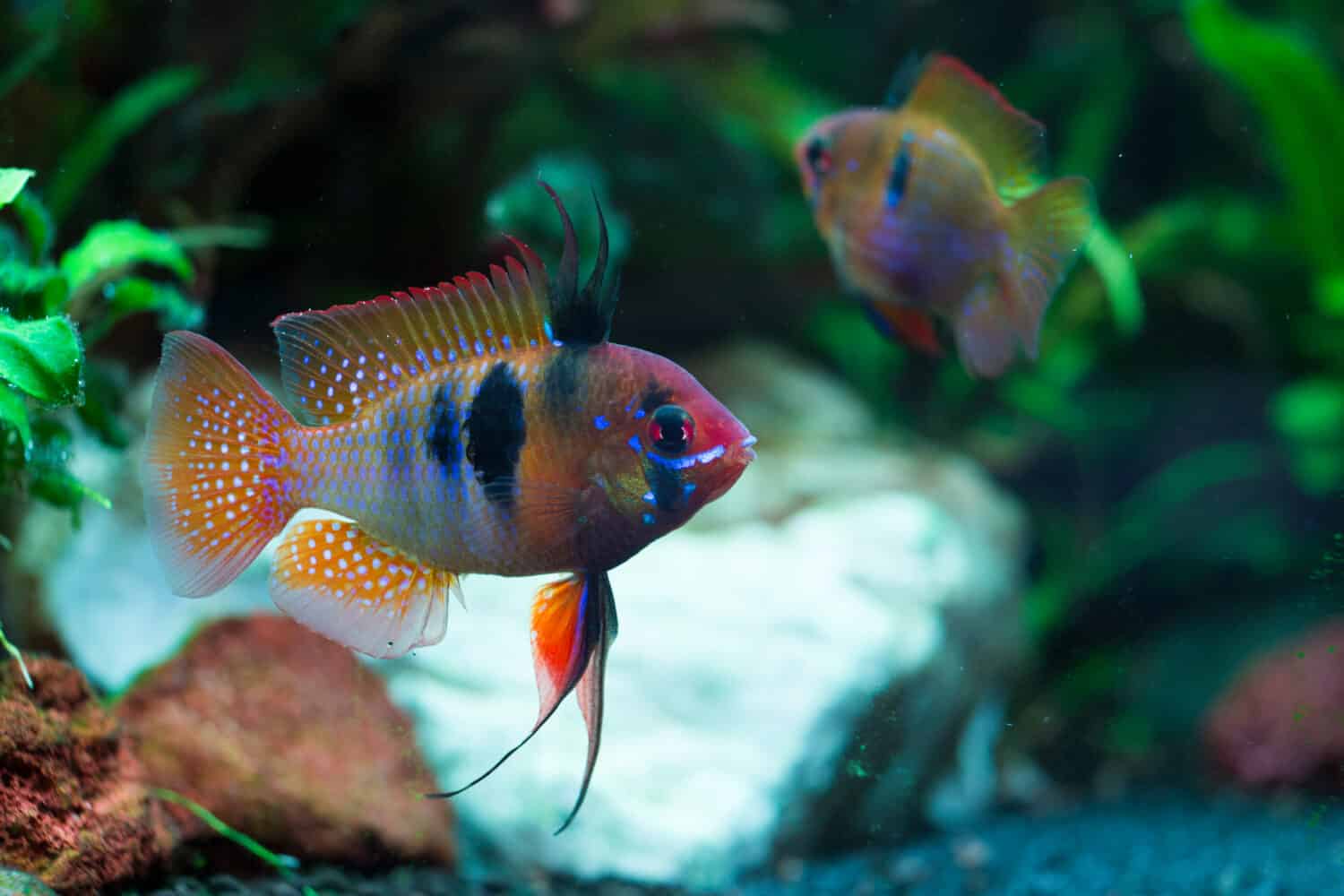
Ramirezi fish are called rams for short.
©Mircea Costina/Shutterstock.com
A German blue ram, scientifically known as Mikrogeophagus ramirezi or simply a ram cichlid, is a stunning and sought-after freshwater fish species. Native to the Orinoco River basin in South America, this small-sized cichlid boasts vibrant colors and unique patterns that make it an exquisite addition to any aquarium. With its compact body shape and elongated fins, the German blue ram exhibits hues ranging from electric blue to golden yellow on its scales.
Renowned for their peaceful nature, these captivating fish thrive in calm and well-maintained aquariums with ample hiding spots provided by plants or rocks. They prefer soft acidic water conditions resembling their natural habitat and water temperatures of 80-86°F. Despite being relatively delicate compared to other cichlids, they are highly intelligent creatures. They exhibit fascinating behaviors such as mouthbrooding.
It is best to keep German Blue Rams in pairs or small groups within community tanks featuring similarly docile species like tetras. They are good tank mates for dwarf gouramis. Their striking appearance, combined with their mild temperament, makes them a popular choice among aquarists who seek both beauty and tranquility within their aquatic habitats.
14. Pearl Gourami
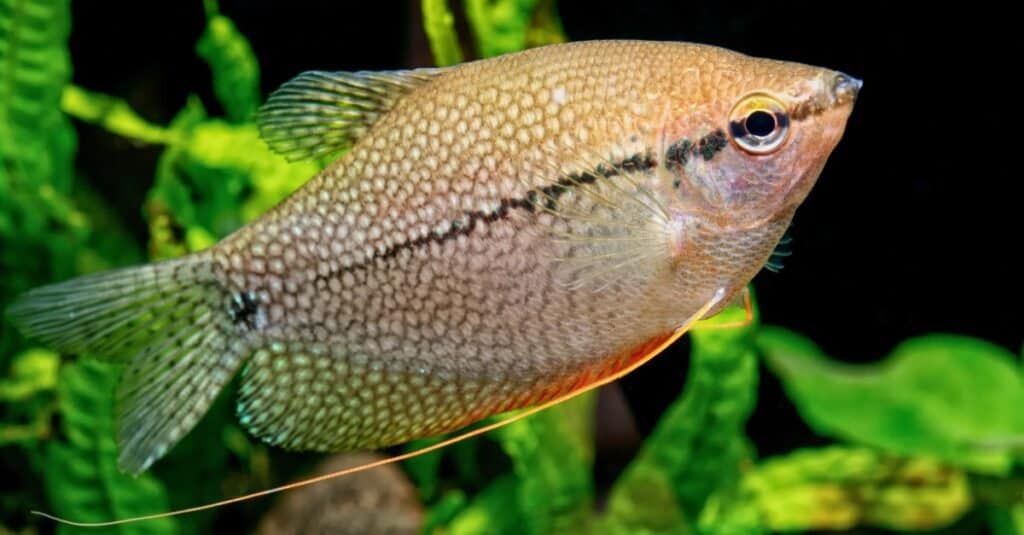
Pearl gourami is one of the few gourami fish that gets along well with dwarf gourami.
©iStock.com/NERYX
The pearl gourami (Trichopodus leerii) is a captivating freshwater fish that belongs to the family Osphronemidae. Known for its stunning appearance, this species is native to Southeast Asia, specifically found in countries like Thailand and Malaysia.
With an elongated body reaching up to five inches in length, the pearl gourami showcases a remarkable combination of colors and patterns. Its opalescent scales shimmer with hues ranging from silver to gold, accentuated by dark vertical stripes running along its body.
This peaceful and sociable species thrives best in well-maintained aquariums with dense vegetation providing ample hiding spots. Additionally, their diet primarily consists of small insects, crustaceans, and plant matter. The pearl gourami’s alluring beauty, coupled with its gentle temperament, make it a desirable tank mate for dwarf gourami.
15. Zebra Loach
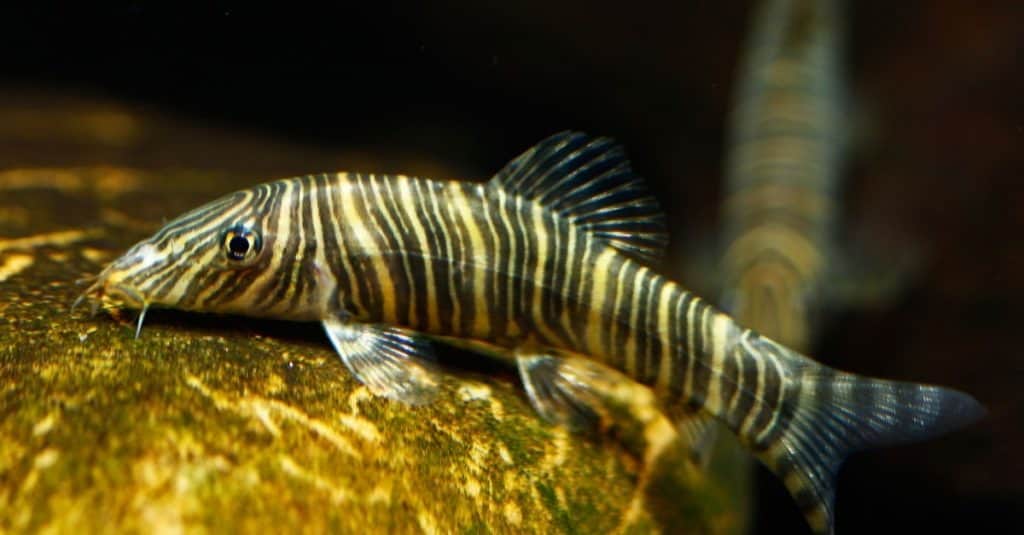
The captivating and beautiful zebra loach makes a great tank mate for dwarf gourami.
©Pavaphon Supanantananont/Shutterstock.com
A zebra loach, scientifically known as Botia striata, is a fascinating freshwater fish species that captivates aquarium enthusiasts with its unique characteristics. Native to the rivers and streams of Southeast Asia, particularly in regions like Malaysia and Indonesia, these loaches thrive in well-maintained aquatic environments. With an elongated body covered in striking black and white stripes resembling a zebra pattern, they display stunning visual appeal.
Measuring around 3-4 inches in length when fully grown, zebra loaches prefer living in groups rather than a solitary existence. They are highly social creatures that exhibit intricate social behaviors within their shoals. These active bottom-dwellers possess barbels near their mouths which aid them in scavenging for food amidst gravel or sand substrates.
Zebra loaches are renowned for their captivating personality traits, such as curiosity and playful nature. Their peaceful demeanor makes them excellent tank mates for various peaceful community fish species like dwarf gouramis. When you provide them with suitable hiding spots and vegetation-rich surroundings, these delightful striped companions contribute to creating a lively aquatic ecosystem worth admiring.
16. Leopard Loach
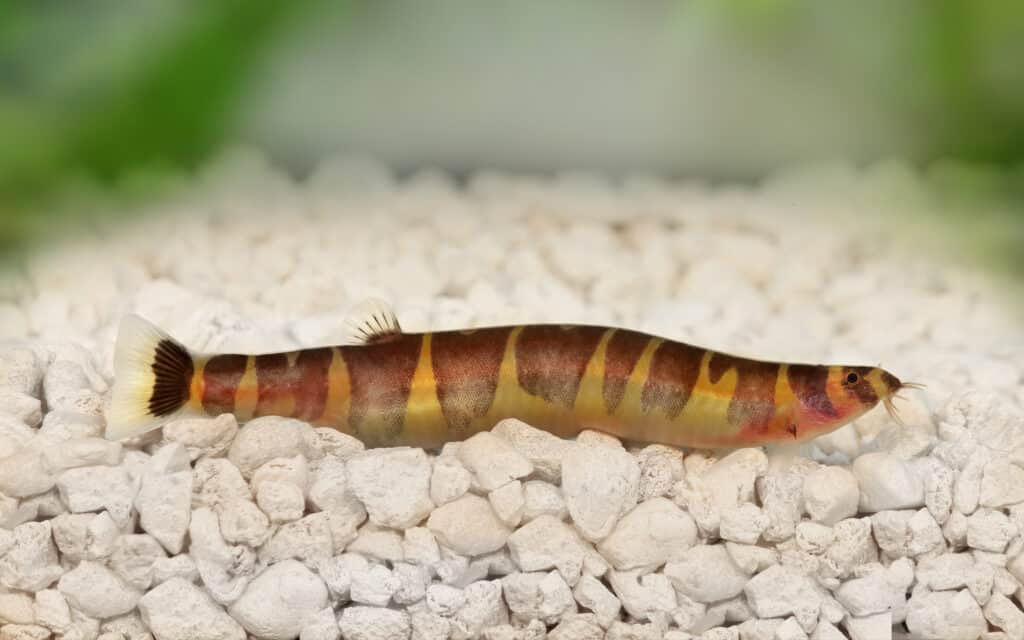
Kuhli loaches are part of the Cobitidae (loach) family.
©iStock.com/Mirko_Rosenau
The leopard loach, scientifically known as Pangio kuhlii but often referred to as the kuhli loach or coolie loach, is a fascinating aquatic creature that can make for an excellent tank mate alongside dwarf gouramis. Its unique appearance is characterized by its elongated and eel-like body structure. They are adorned with distinctive dark brown or black markings resembling leopard spots. This small freshwater fish typically reaches about three to four inches in length when fully grown.
Originating from Southeast Asia, particularly Thailand, and Malaysia, the leopard loach thrives in slow-moving rivers and streams with sandy or muddy substrates. It possesses a peaceful temperament and prefers living in groups of at least four individuals, providing it with a sense of security within an aquarium setting.
While primarily nocturnal, these loaches may become more active during feeding times or when provided with hiding places such as caves or driftwood. They are opportunistic omnivores that readily consume both live and frozen foods like bloodworms, brine shrimp, daphnia, and high-quality commercial pellets.
With their intriguing patterns and tranquil nature, leopard loaches can add diversity and visual interest to your dwarf gourami tank while harmoniously coexisting with them.
17. Harlequin Rasboras

Trigonostigma heteromorpha, or harlequin rasbora, are native to Asia.
©nadiia_oborska/Shutterstock.com
A harlequin rasbora (Trigonostigma heteromorpha) is a small and vibrant freshwater fish that belongs to the Cyprinidae family. Native to Southeast Asia, specifically Thailand, Malaysia, and Indonesia, they are commonly found in slow-moving rivers and streams with dense vegetation.
These peaceful fish are highly sought after for their striking appearance, characterized by a shimmering silver body adorned with contrasting black triangular patterns on the upper half and an orange-red hue on the lower half of their bodies. With a maximum size of around 2 inches, harlequin rasboras make excellent tank mates for dwarf gouramis due to their calm nature and compatibility with similar water parameters.
18. Otocinclus Catfish
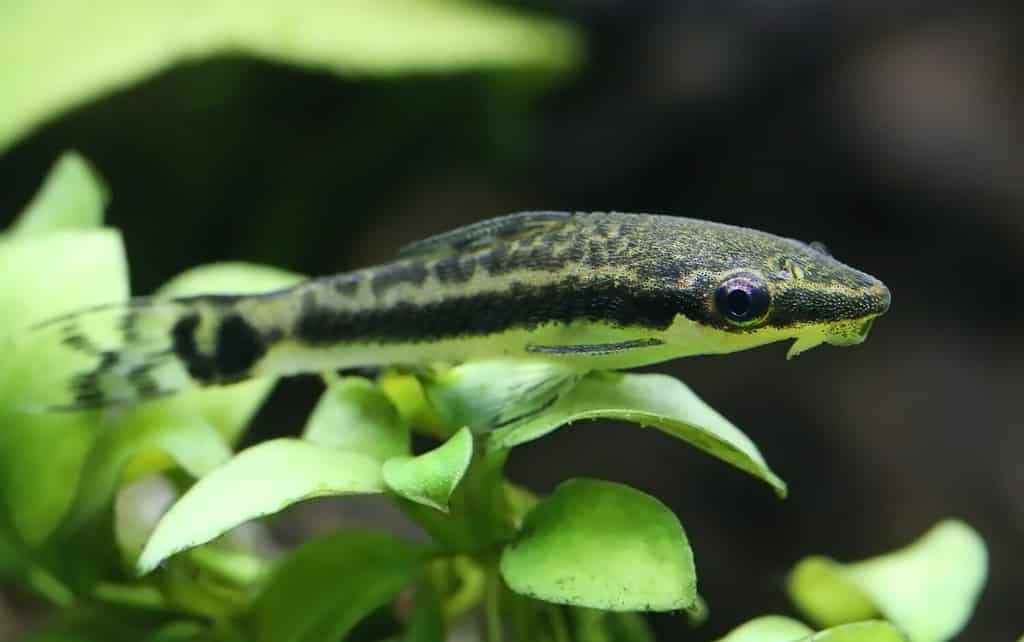
Otocinclus catfish is also called the dwarf armored catfish.
©Swapan Photography/Shutterstock.com
An Otocinclus catfish, scientifically known as Macrotocinclus affinis, is a diminutive and fascinating species commonly referred to as the dwarf armored catfish. Native to South America, these small freshwater fish are highly sought after in the aquarium hobby due to their unique characteristics and beneficial qualities.
Growing up to two inches in size, Otocinclus catfish possess an elongated body covered with rows of bony plates or armor-like scales that provide protection against potential predators. Renowned for their algae-eating abilities, they play a vital role in maintaining tank cleanliness by consuming unwanted algae growth on various surfaces. With their peaceful nature and compatibility with numerous fish species, these delightful creatures make excellent companions for aquarists seeking harmony within their aquatic ecosystems. These fish are great tank mates for dwarf gourami and peaceful, schooling fish.
19. Cardinal Tetra
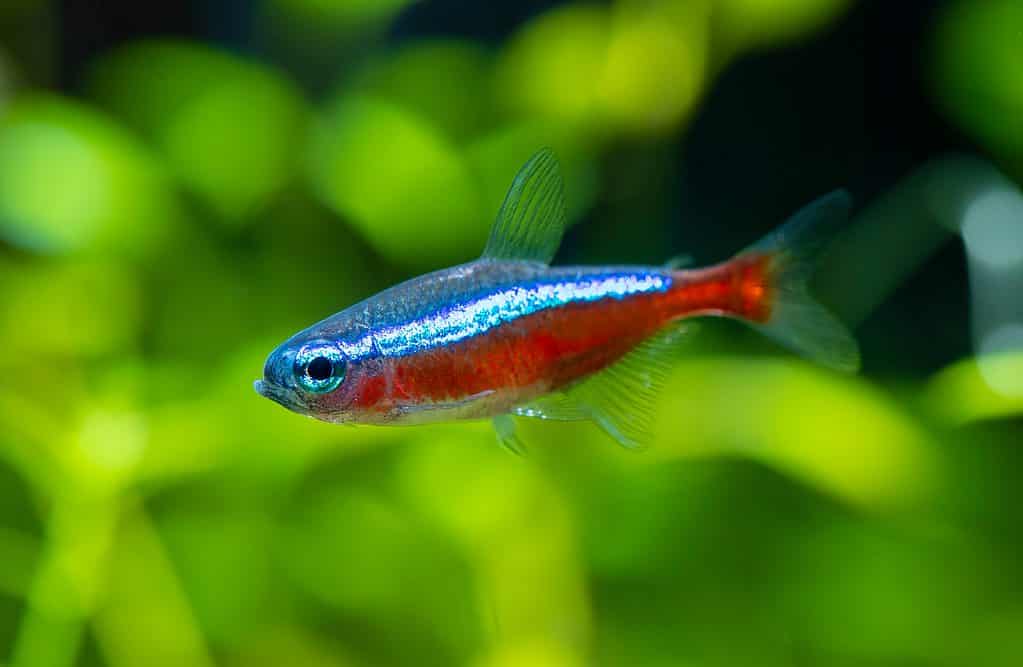
The colors of the cardinal tetra are beautiful in a community tank.
©NattapolStudiO/Shutterstock.com
A cardinal tetra (Paracheirodon axelrodi) is a vibrant and eye-catching freshwater fish that originates from the Amazon Rainforest. With its stunning appearance, it has become a popular choice among aquarium enthusiasts.
This small-sized tetra typically grows up to 1.5 inches long and boasts beautiful colors of deep red on its body, contrasting with iridescent blue stripes that extend horizontally from its midsection to the tail fin.
Known for their peaceful nature, cardinal tetras thrive in groups and create a mesmerizing display when kept in well-planted tanks with subdued lighting. They are highly social creatures and make excellent tank mates for dwarf gourami and other community fish. This is due to their calm temperament and non-aggressive behavior.
20. Black Skirt Tetra
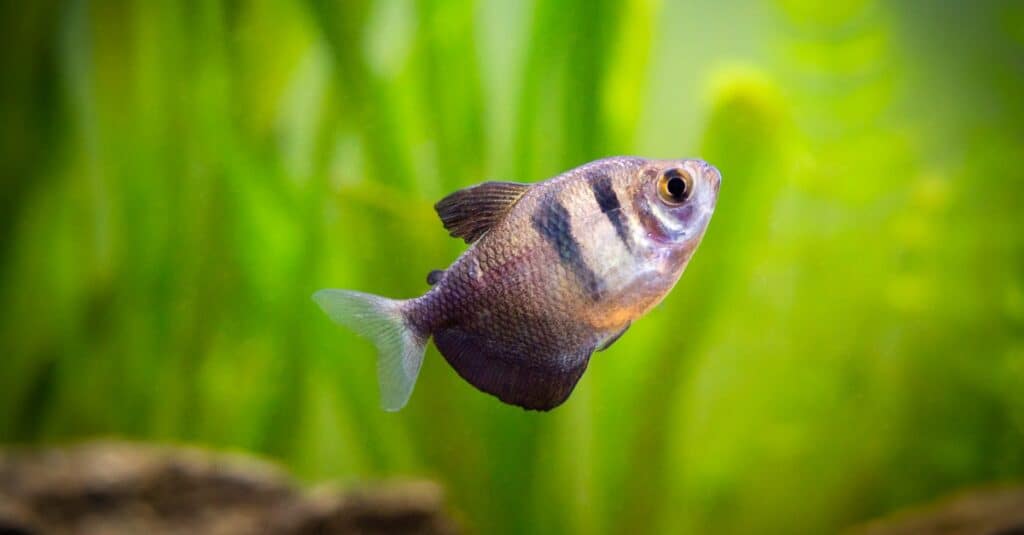
Black skirt tetra gets its name from its black, skirt-like fin.
©iStock.com/Juan Carlos Juarez Jaramillo
The black skirt tetra, scientifically known as Gymnocorymbus ternetzi, is a popular freshwater fish species among aquarium enthusiasts. With its sleek and streamlined body shape, this tetra showcases stunning elegance in its appearance. Sporting a predominantly silver coloration with a distinguishing black vertical stripe that runs along the length of its body, it adds an eye-catching contrast to any tank setting.
Known for their peaceful nature and sociable behavior, black skirt tetras are often recommended as ideal tank mates for dwarf gouramis. These small-sized tetras thrive in groups, exhibiting shoaling tendencies that create an engaging display within the aquarium. Their adaptability to various water conditions makes them suitable for both experienced hobbyists and beginners alike.
21. Cherry Barb
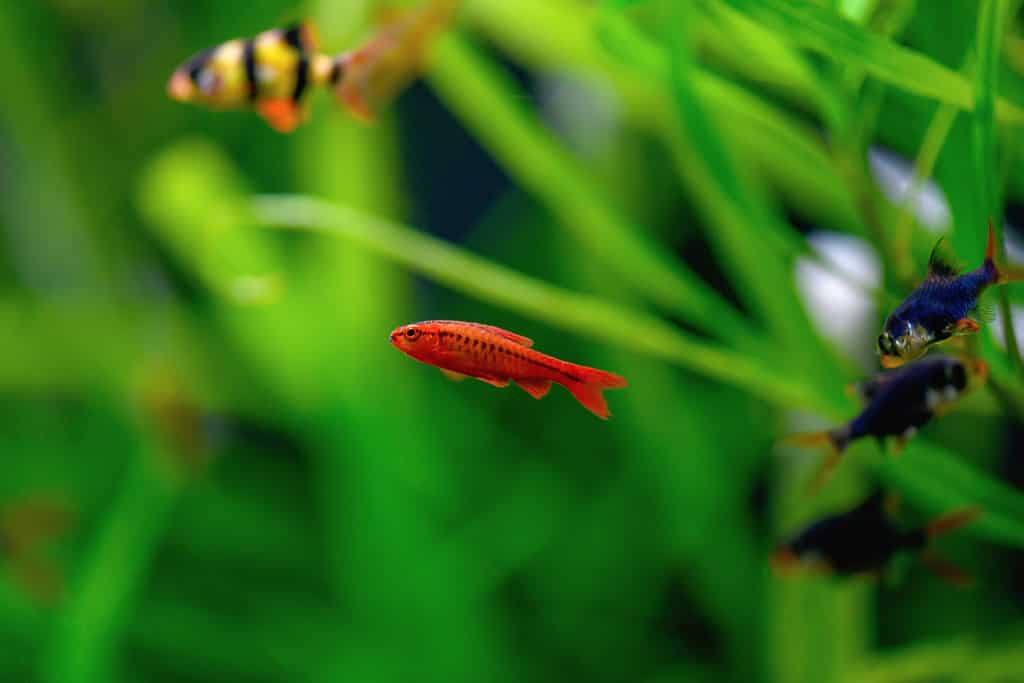
If you are looking for the ideal tank mate for dwarf gourami, the cherry barb may be for you!
©Bk87/Shutterstock.com
A cherry barb (Puntius titteya) is a lively and vibrant freshwater fish that hails from Sri Lanka. With its striking colors and playful nature, it has become a popular choice for aquarium enthusiasts. Growing up to 2 inches in length, the cherry barb showcases a radiant red-orange body with shimmering silver accents along its sides. Its dorsal fin displays an elegant black spot, adding to its visual appeal.
Known for their peaceful temperament, cherry barbs are social creatures that thrive in schools of six or more individuals. They prefer well-planted aquariums with plenty of hiding spots and open swimming areas. These omnivorous fish have an appetite for both live foods like daphnia and brine shrimp as well as high-quality flakes or pellets.
Due to their small size and easy-going nature, cherry barbs make excellent tank mates for other peaceful community fish such as guppies, tetras, rasboras, or dwarf gouramis. When provided with suitable conditions and companionship, these captivating little fish can bring life and color to any aquarist’s collection.
| Number | Tank Mates for Dwarf Gourami |
|---|---|
| 1 | Mollies |
| 2 | Guppies |
| 3 | Southern Playfish |
| 4 | Swordtails |
| 5 | Neon Tetra |
| 6 | Chili Rasboras |
| 7 | Zebrafish |
| 8 | Cory Catfish |
| 9 | Angelfish |
| 10 | Bristlenose Plecos |
| 11 | Siamese Algae Eaters |
| 12 | Glass Catfish |
| 13 | German Blue Rams |
| 14 | Pearl Gourami |
| 15 | Zebra Loach |
| 16 | Leopard Loach |
| 17 | Harlequin Rasboras |
| 18 | Otocinclus Catfish |
| 19 | Cardinal Tetra |
| 20 | Black Skirt Tetra |
| 21 | Cherry Barb |
The photo featured at the top of this post is © Andrej Jakubik/Shutterstock.com
Thank you for reading! Have some feedback for us? Contact the AZ Animals editorial team.






